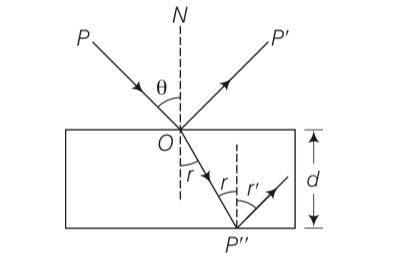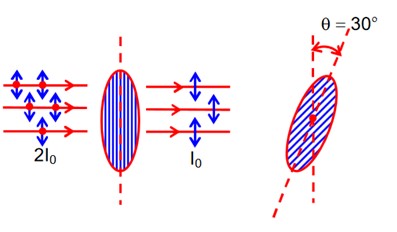Consider a ray of light incident from air onto a slab of glass (refractive index n) of width d, at an angle θ. The phase difference between the ray reflected by the top surface of the glass and the bottom surface is
(a) ( )1/2+
(b) ( )1/2
(c) ( )1/2+ /2
(d) ( )1/2+
Consider a ray of light incident from air onto a slab of glass (refractive index n) of width d, at an angle θ. The phase difference between the ray reflected by the top surface of the glass and the bottom surface is
(a) ( )1/2+
(b) ( )1/2
(c) ( )1/2+ /2
(d) ( )1/2+
-
1 Answer
-
This is a Multiple Choice Questions as classified in NCERT Exemplar
Answer- a
Explanation- due to refraction from the glass medium there is a phase change of
= =

According to snells law n= sin /sinr
Cosr =
= ( )
Phase difference = = = ( )
So net difference = = ( )-1/2+
Similar Questions for you
At lower end
Tension, T? = 2g = 20 N (due to the 2 kg block)
Velocity, v? = √ (T? /μ) = √ (20/μ)
Wavelength, λ? = 6 cm
At upper end
Tension, T? = (2 kg + 6 kg)g = 8g = 80 N (due to the block and the rope)
Velocity, v? = √ (T? /μ) = √ (80/μ) = √4 * √ (20/μ) = 2v?
Since frequency (f) remains the same:
f = v? /λ? = v? /λ?
⇒ λ? = λ? * (v? /v? )
⇒ λ? = λ? * (2v? /v? ) = 2λ?
⇒ λ? = 2 * 6 cm = 12 cm
β = λD / (d? + a? sinωt)
β? - β? = λD/ (d? - a? ) - λD/ (d? + a? )
= λD [ (d? + a? ) - (d? - a? ) / (d? ² - a? ²) ]
= 2λDa? / (d? ² - a? ²)
3d = 0.6mm
D = 80cm
= 800mm
Path difference is given by
BP – Andhra Pradesh = Dx
[for Dark fringe at P]
n = 0, for first dark fringe
first dark fringe is observed on the screen directly opposite to one of the slits]
The distance between two successive bright fringes is fringe width .
Taking an Exam? Selecting a College?
Get authentic answers from experts, students and alumni that you won't find anywhere else
Sign Up on ShikshaOn Shiksha, get access to
- 65k Colleges
- 1.2k Exams
- 687k Reviews
- 1800k Answers

